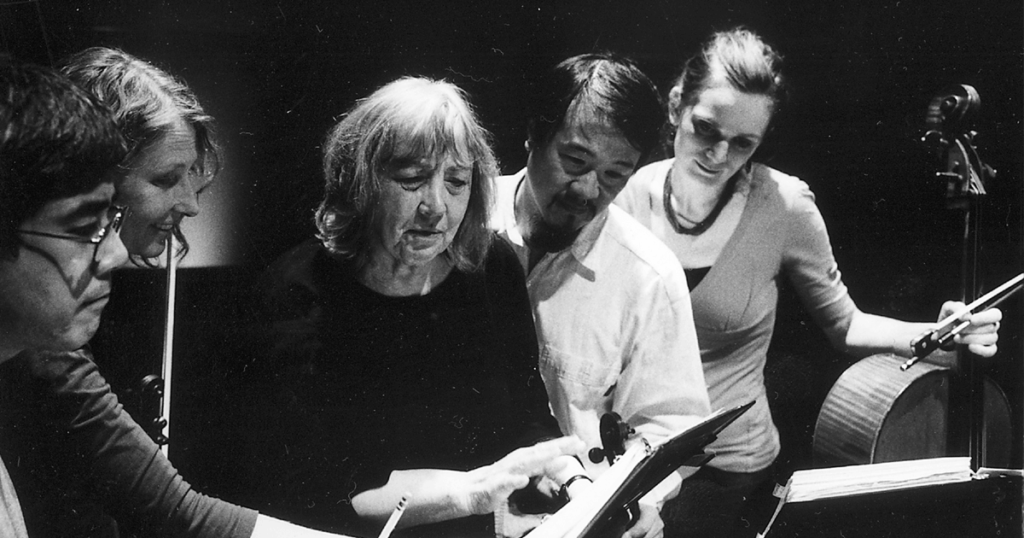
Some months ago, when compiling a list of seminal American symphonies, I neglected to include even one work by the wildly prolific Gloria Coates, a composer born in Wisconsin in 1938 who has, since 1969, made her home in Munich. I’ve spent considerable time of late getting to know what amounts to just a tiny portion of Coates’s output, which includes chamber and vocal works, pieces for the theater, and 16 symphonies (among other large-scale compositions)—an immense amount of distinctive, unforgettable music. For one thing, how many other contemporary composers are so immediately recognizable? It’s been said that an intrepid listener can identify a Coates symphony or string quartet within a few measures. Part of this inimitability has to do with the materials of her music: not only the contrapuntal techniques and percussive effects, but also her prominent use of glissando, that is, the upward or downward gliding from note to note—think of the famous swooping clarinet line, covering more than two octaves, that opens George Gershwin’s Rhapsody in Blue.
Indeed, that famous Gershwin glissando left a deep impression on Coates, who as a young singer also became interested in the many tones and microtones that could be rendered when sliding between notes. In her student days, she even composed a string quartet—her first—comprised of nothing but glissandos. Her teachers may have been puzzled, but Coates was undeterred. Already she was excelling as a painter as well as a musician, and those glissandos represented in sound the shapes and structures she set down on canvas. Her glissandos vary in length and in intensity and are meticulously notated in her scores. They can unsettle the ear or bring great solace, but no matter their emotional effect, they are as essential as the hymn-like chorales that often lie at the heart of Coates’s pieces.
You could begin an exploration of her music almost anywhere, yet I would recommend starting, as I did, with her Symphony No. 1 (1972–73), a work initially called Music on Open Strings. (Coates hadn’t conceived of it as a symphony when she composed it; she happened to write a few large-scale symphonic works, giving them various descriptive titles, before realizing that what she really had on her hands were symphonies.) She dedicated this first symphony to Alexander Tcherepnin, the Russian-born composer who had emigrated to the United States in 1948 and who taught Coates in Chicago and at the Mozarteum in Salzburg.
The work begins with a haunting, seemingly simple theme built on five notes—an Eastern pentatonic scale, it turns out, with the strings tuned to unconventional pitches via a technique called scordatura. On a violin, for example, the open strings are typically tuned to G, D, A, and E. But if the violinist were to flatten or sharpen those tunings, the open strings—let’s say, tuned to B flat, C, D flat, and F—can produce unexpected resonances and overtones. Coates’s principal theme, then, feels exotic, and soon, various effects are introduced: menacing tremolos, two kinds of pizzicato (the strings both plucked and snapped), and the sound of wood bows striking the bodies of the stringed instruments. As the lines grow in force and complexity, the glissandos take over, the music swirling like a sonic sandstorm—dizzying and disorienting—though underneath it all, discernible at all times, is that hymn-like theme transformed into many guises.
The second movement, a scherzo, is more rhythmic, the percussive sounds of wood on wood becoming more prominent, the sonic world of microtonal clusters quivering and alive. In the third movement, the instrumentalists once again begin by playing open strings using scordatura, but eventually they do something audacious: they retune their strings as they play. As an experiment in sonority, this third movement is beguiling. Yet there are metaphorical implications, as well. The first thing a string player learns to do, after all, is draw the bow across the open strings (only later are fingers placed on the fingerboard to produce other notes). Moreover, before playing even a single note, string players must first tune their instruments, producing small arcs of microtones above and below the intended pitch as the tuning pegs are loosened and tightened. Hearing this tuning up (or tuning down) in the context of Coates’s music, I am reminded of other musical passages depicting the beginnings of things, such as the opening bars of Franz Joseph Haydn’s Creation or George Frideric Handel’s Samson before that, in which we hear a world coalescing from the chaos of colliding atoms. Before the third movement concludes, the strings return to conventional tuning—a powerful, overwhelming moment of consonance. Let there be light, Coates seems to be saying, and so there is.
The symphony’s final movement reveals the composer’s mastery of counterpoint (she has long been interested in contrapuntal music, particularly the Renaissance works of Orlando di Lasso and the so-called isorhythmic motets of the 14th century). Here we have a symmetrical canon, the thick swirls of sound turning upon themselves, building steadily and ominously, with the glissandos revealing a spectrum of microtones. The strings sound almost machine-like at times, the orchestra resembling a giant synthesizer. When the music dies away, we hear the open strings emerging from the clouds of sound like distant memories, or fragments of dreams, before the intensity builds back up again, the music swelling to a powerful climax.
That I’m coming to Coates’s music so late seems almost a sin. Yet I can happily attest that once you become acquainted with her scores, it’s hard to get those wondrous sounds, those tone clusters and glissandos and chant-like chorales, out of your head. She may indeed be the most prolific woman symphonist in the history of Western music, but that is just one reason to dive headlong into her deeply affecting, strangely beautiful work.
Listen to Elgar Howarth lead the Bavarian Radio Symphony Orchestra in this performance of Gloria Coates’s Symphony No. 1:

